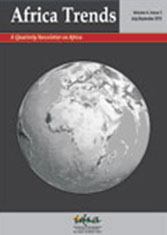Editorial Board
Editor:
Ruchita Beri
Associate Editor:
Rajeesh Kumar

Africa Trends is the IDSA’s Biannual magazine on Africa. The magazine aims to provide readers with reviews and analysis of significant and strategic developments taking place in African countries that impact regional and global security. The publication features commentaries and analyses of contemporary developments in Africa and a Book Review section.
The Africa Trends team invites book reviews and commentaries for publication in upcoming issues of the magazine. Submissions can focus on political and economic issues relating to African countries. We would also be interested in articles analysing bilateral, regional and multilateral developments of strategic significance to India’s engagement with African countries. Commentaries can range between 1,000-1,500 words (excluding footnotes) and book reviews between 600-1,000 words. Contributions may be emailed to the Editor at idsa.africatrends@gmail.com.